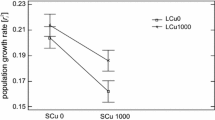Abstract
The hypothesis that natural selection is capable of maintaining allozyme variation in natural populations was tested using a species of flour beetles,Tribolium confusum. We selected a polymorphic locus (a locus encoding variation for malic enzyme) in an experimental population ofT. confusum and scored the genotypes at this locus for a series of fitness components on different flour types. Measurements included survival rate, development time, fecundity, and rate of egg cannibalism. Flour type had significant effects on most traits. Significant differences among genotypes for fecundity and rates of egg cannibalism and the presence of genotype × flour type interactions for development time were demonstrated. Thus, changes in allele frequencies at the malic enzyme locus could in part be under the influence of natural selection. The existence of genotype × flour type interactions suggests that environmental heterogeneity could maintain allozyme variation at the malic enzyme locus.
Similar content being viewed by others
References
Berger, E. M. (1971). A temporal survey of allelic variation in natural and laboratory populations ofD. melanogaster.Genetics 67121.
Christensen, F. B., and Feldman, M. W. (1975). Subdivided populations: A review of the one and two-locus deterministic theory.Theoret. Pop. Biol. 713.
Dawson, P. S., and Riddle, R. A. (1983). Genetic variation, environmental heterogeneity, and evolutionary stability. In King, C. E., and Dawson, P. S. (eds.),Population Biology: Retrospect and Prospect Columbia University Press, New York.
Felsenstein, J. (1976). The theoretical population genetics of variable selection and migration.Annu. Rev. Genet. 10253.
Gibson, J. (1970). Enzyme flexibility inD. melanogaster.Nature 227959.
Harris, H. (1966). Enzyme polymorphisms in man.Proc. R. Soc. B 164298.
Hedrick, P. W., Ginevan, M. E., and Ewing, E. P. (1976). Genetic polymorphism in heterogeneous environments.Annu. Rev. Ecol. Syst. 71
Koehn, R. K. (1969). Esterase heterogeneity: Dynamics of a polymorphism.Science 163943.
Lewontin, R. C. (1974).The Genetic Basis of Evolutionary Change Columbia University Press, New York.
Lewontin, R. C., and Hubby, J. L. (1966). A molecular approach to the study of genic heterozygosity in natural populations. II. Amount of variation and degree of heterozygosity in natural populations ofDrosophila pseudoobscura.Genetics 54595.
Marinkovic, D., and Ayala, F. J. (1975). Fitness of allozyme variants inDrosophila pseudoobscura. I. Selection at the PGM-1 and ME-2 loci.Genetics 7985.
McDonald, J. F., and Ayala, F. J. (1974). Genetic response to environmental heterogeneity.Nature 250572.
Nei, M., Maruyama, T., and Chakraborty, R. (1975). The bottleneck effect and genetic variability in populations.Evolution 291.
Nevo, E. (1978). Genetic variation in natural populations: Patterns and theory.Theoret. Pop. Biol. 13121.
Place, A. R., and Powers, D. A. (1979). Genetic variation and relative catalytic efficiencies: Lactate dehydrogenase B allozymes ofFundulus heteroclitus.Proc. Natl. Acad. Sci. USA 762354.
Powell, J. R. (1971). Genetic polymorphisms in varied environments.Science 1741035.
Powell, J. R., and Taylor, C. E. (1979). Genetic variation in ecologically diverse environments.Am. Sci. 67590.
Powell, J. R., and Wistrand, H. (1978). The effect of heterogeneous environments and a competitor on genetic variation inDrosophila.Am. Nat. 112935.
Rich, E. R. (1956). Egg cannibalism and fecundity inTribolium.Ecology 37109.
Riddle, R. A., Iverson, V., and Dawson, P. S. (1983). Dietary effects on fitness components at the PGM-1 locus ofTribolium castaneum.Genetics 10365.
Riddle, R. A., Dawson, P. S., and Zirkle, D. F. (1986). An experimental test of the relationship between genetic and environmental variation inTribolium flour beetles.Genetics 113391.
Samollow, P. B., Dawson, P. S., and Riddle, R. A. (1983). X-linked and autosomal inheritance patterns of homologous genes in two species ofTribolium.Biochem. Genet. 21167.
Schedecor, G. W., and Cochran, W. G. (1967).Statistical Methods 6th ed., Iowa State University Press, Ames.
Snyder, T. P., and Ayala, F. J. (1979). Temperature and density effects on fitness at the MDH-2 and PGM-1 loci ofDrosophila pseudoobscura.Genetica 5159.
Watt, W. B., Cassin, R. C., and Swam, M. S. (1983). Adaptation of specific loci. III. Field behavior and survivorship differences amongColias PGI genotypes are predictable from in vitro biochemistry.Genetics 103725.
Yarbrough, K. M., and Kojima, K. (1967). The mode of selection at the polymorphic esterase-6 locus in cage populations ofDrosophila melanogaster.Genetics 67579.
Zirkle, D. F., and Riddle, R. A. (1983). Quantitative genetic response to environmental heterogeneity inTribolium confusum.Evolution 37637.
Author information
Authors and Affiliations
Rights and permissions
About this article
Cite this article
Zirkle, D.F., Dawson, P.S. An experimental analysis of the relationships between fitness components and malic enzyme genotypes inTribolium confusum . Biochem Genet 26, 277–286 (1988). https://doi.org/10.1007/BF00561466
Received:
Revised:
Issue Date:
DOI: https://doi.org/10.1007/BF00561466




